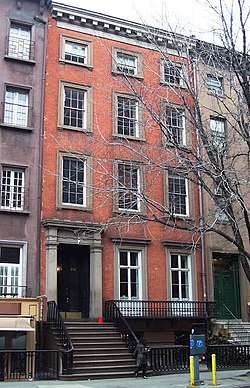Norwood Club
The Norwood Club is a private club located in the Chelsea neighborhood of Manhattan in New York City. It was founded in 2007 by Alan Linn and Steve Ruggi,[2] who intended it to be a modern incarnation of the traditional gentlemen's club.[3] Like the fine arts focused Century Association, the Norwood Club draws its membership from New York City's arts and creative community.[4] Linn describes the Norwood Club as a "club for the curious."[5] The Norwood Club's members have reciprocity with other private clubs in London, Los Angeles, San Francisco, South Africa, Sydney, Paris, Dublin, Budapest, Toronto, Buenos Aires, and Shanghai.
Andrew Norwood House The Norwood Club | |
 (2011) | |
 Location in New York City | |
| Location | 241 West 14th Street Manhattan, New York City |
|---|---|
| Coordinates | 40°44′22.92″N 74°00′06.84″W |
| Built | 1845-1847[1] |
| Architectural style | Greek Revival[1] Italianate[1] |
| Website | www |
| NRHP reference No. | 79001606 |
| Significant dates | |
| Added to NRHP | July 9, 1979 |
| Designated NYCL | May 9, 1978 |
Clubhouse
The Norwood Club is located in a five-story brownstone townhouse at 241 West 14th Street between Seventh and Eighth Avenues built in 1847 for bond merchant Andrew S. Norwood – who was an active developer in the 14th Street area[6] – and known as the Andrew Norwood House.[7][8][9] In the 1840s, Norwood built three townhouses on the north side of West 14th Street between 7th and 8th Avenues, including the Norwood House, which then was a fashionable area of northern Manhattan.[8] The matching houses, which were the first brick or masonry residences to be built on the street, were designed in the Italianate style with late Greek Revival details.[10][1] Norwood and his family moved into the Norwood House in 1847,[8] and the two houses to the left and right of #241, at #239 and #243, were sold by the beginning of 1853;[1] #243 was later a speakeasy called the Tammany Tough Club.[10] Andrew S. Norwood's son, Andrew G. Norwood, inherited the home in 1858 following his father's death in 1856.[8][1] It remained in the family until the turn of the century.[1]
Later on, the house was used for various purposes, including a boarding house, the New York Deaconesses Home of the Methodist Church, and a funeral home.[8] In 1976, Raf Borello purchased and restored the home and used it as his private residence until his death in 2005.[8][1] During this time, the building's exterior was given landmark status.[8] In 2006, Borello's heirs sold the home to a group that included Alan Linn who founded the Norwood Club in it.[8] Linn employed British interior designer Simon Costin to convert the space without losing its artistic and historical integrity. The Norwood Club then opened its doors in 2007.[8] The Norwood House contains 13 marble fireplaces, mahogany interior doors, elaborate plaster ceiling moldings, a cast iron balcony, an elegant curving staircase, and a stained glass skylight.[8]
Today, the Norwood Club contains a restaurant, two lounge bars, a screening room and a walled garden with seating. The top floor houses the screening room and a small roof deck.[7] A hidden door on the main floor leads to a staircase to the lower dining room, which members can use for private events.[7] The entire club features paintings, drawings and sculptures that are curated once each year.[7] Many of the art pieces and books that are displayed are from current members.[7]
The house has been a NYC Landmark since 1978 and on the National Register of Historic Places since 1979. It is one of the few townhouses of its type still extant in Manhattan.[1]
Membership
Club membership is selective. The application process includes completing written questions which address one's interests in the arts and motivation for joining Norwood,[11] as well as a required interview and tour of the facilities.[12] The club has about 1100 members, as well as a wait-list for new members.[13]
See also
- List of traditional gentlemen's clubs in the United States
- List of New York City Landmarks
- National Register of Historic Places listings in New York County, New York
References
- Staff (May 9, 1978) "Andrew Norwood House Designation Report" New York City Landmark Preservation Commission
- Staff (April 25, 2010). "Interview: Alan Linn and Steve Ruggi, owners of exclusive New York club Norwood". The Scotsman.
- Axelrod, Nick (April 10, 2012). "Insiders Guide: The Private Clubs". The Hollywood Reporter.
- "The 10 Best Private Clubs". Worth.
- "Art Club: Norwood". No. 3 Magazine.
- New York City Landmarks Preservation Commission; Dolkart, Andrew S.; Postal, Matthew A. (2009). Postal, Matthew A. (ed.). Guide to New York City Landmarks (4th ed.). New York: John Wiley & Sons. p. 59. ISBN 978-0-470-28963-1.
- "Norwood". SOMA Magazine. March–April 2013.
- Miller, Tom (July 6, 2011). "The Andrew S. Norwood House". Daytonian In Manhattan.
- Staff (1989) "Andrew Norwood House" (plaque) New York Landmarks Preservation Foundation
- White, Norval; Willensky, Elliot & Leadon, Fran (2010). AIA Guide to New York City (5th ed.). New York: Oxford University Press. p. 209. ISBN 978-0-19538-386-7.
- "NYC Private Clubs". refinary29.
- Zeveloff, Julie (June 20, 2011). "The Most Exclusive Private Clubs in New York City". Business Insider.
- Catton, Pia (September 2, 2013). "Arts Clubs Go Soul-Searching in New Era". The Wall Street Journal.
External links
| Wikimedia Commons has media related to Norwood Club. |

